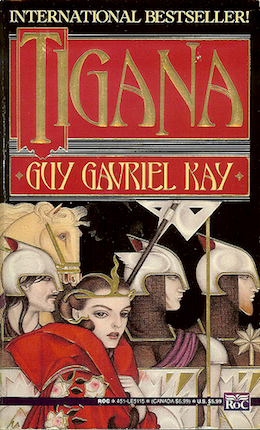As an aspiring writer and voracious fantasy reader years (and years) ago, the aspect that intrigued me most and kept me reading and writing fantasy was the uniqueness of the world that could be found among the pages of each book. The arcane magic, the otherworldly creatures, and the never-before-seen races and creatures that inhabited the world captured my imagination and took me to new realms of awe and wonder. That is why it’s called fantasy, after all, isn’t it? The “new” is why we enjoy it so much, right?
So imagine the utter shock while reading Tigana by Guy Gavriel Kay that it was the familiar that made the new so special.
It changed the way I wrote and the way I read fantasy novels. I realized that, as an aspiring writer, I’d been attempting to worldbuild the wrong way. I was trying to create worlds anew from whole cloth—new cultures, new races, new magic, new everything. But after this epiphany, I realized that the only reason all of the newness—all of the magic, all of the creatures—was so interesting was because it was being contrasted against a backdrop that was essentially 90 percent familiar. The idea that in order for fantasy to work well, to have as much power as it has, comes from the fact that the majority of the world where it’s set is essentially the real world was, frankly, stunning.
I didn’t need to create a new creature or new culture; I could take a setting from the real world—past or present—and make it the base for a creature or culture instead. All I needed to do to make the familiar new and fresh was change small aspects of that world, or add in something new and determine how the world would have to change in order to accommodate it.
In Tigana, Guy Gavriel Kay creates a world centered on the culture of Italy. No, the peninsula isn’t shaped like a boot, and no, the culture isn’t exactly like Renaissance Italy, but the flavor of Italy is there—in the word structure, the place names, the characters; in the gestures, the traditions, the everyday force of life moving people forward. Behind the fantasy façade is a real-world foundation that’s recognizable, and it’s that familiarity that grounds the reader and provides them with stability for when the true magic of the world begins.
Needless to say, I devoured Tigana and then A Song for Arbonne and The Fionavar Tapestry and the many other worlds created by Guy Gavriel Kay. He is a master at taking a recognizable setting from our world—a place or a culture—and transforming it into something otherworldly, while still retaining that sense of the familiar, that sense of having been there. And isn’t that one of the most essential elements of fantasy writing? Aren’t we all attempting to create a world that makes the reader feel as if they’ve lived there?
How he does is it arcane in and of itself, and I must confess that after years of study of not only Guy Gavriel Kay’s novels, but practically every other fantasy novel I’ve read, I have still not divined fully his art. Certainly there are obvious alterations to bring the reader out of the familiar world and into the fantasy realm, such as having two moons or changing the landscape, but these are mere cosmetic changes. Kay’s craft is much more subtle. He alters the familiar through all aspects of life, down to arbitrary everyday rituals, including myths and legends and superstitions, such as the extremely powerful lore of the riselka in Tigana. Even thinking of the riselka now sends shivers down my back, evoking so effectively the chilling end to Tigana. Kay manages to take each such change—cosmetic or otherwise—and incorporate it into the familiar seamlessly. Each change not only alters the world, making it feel more fantastic, but also informs the world, shaping it at such depths that the reader cannot fathom removing that aspect from the world at all. It becomes intrinsic and informs and plays off of every other aspect of the world, until it can only be viewed as a whole, without separate parts. And that whole is also wholly new, even with that base of familiarity.
Most writers, when speaking of Guy Gavriel Kay’s work, talk of his deft and lyrical skill with language. His writing is evocative, even impressionistic in places, and certainly transports one to a different world with simple word choices and turns of phrase. But for me, the true art of Kay’s work is not in the use of language, but in the subtle way he skews what is so obviously a familiar setting into something fantastical and mysterious and completely different. That is the power of Guy Gavriel Kay’s work, and it is nothing short of awesome.
 Joshua Palmatier is a writer and a mathematician. He was born in Pennsylvania, but has lived in numerous states over his life and currently resides in Binghamton, New York, and is a tenured professor of mathematics at Oneonta. Threading the Needle, the sequel to Shattering the Ley, is available July 5th from DAW.
Joshua Palmatier is a writer and a mathematician. He was born in Pennsylvania, but has lived in numerous states over his life and currently resides in Binghamton, New York, and is a tenured professor of mathematics at Oneonta. Threading the Needle, the sequel to Shattering the Ley, is available July 5th from DAW.










